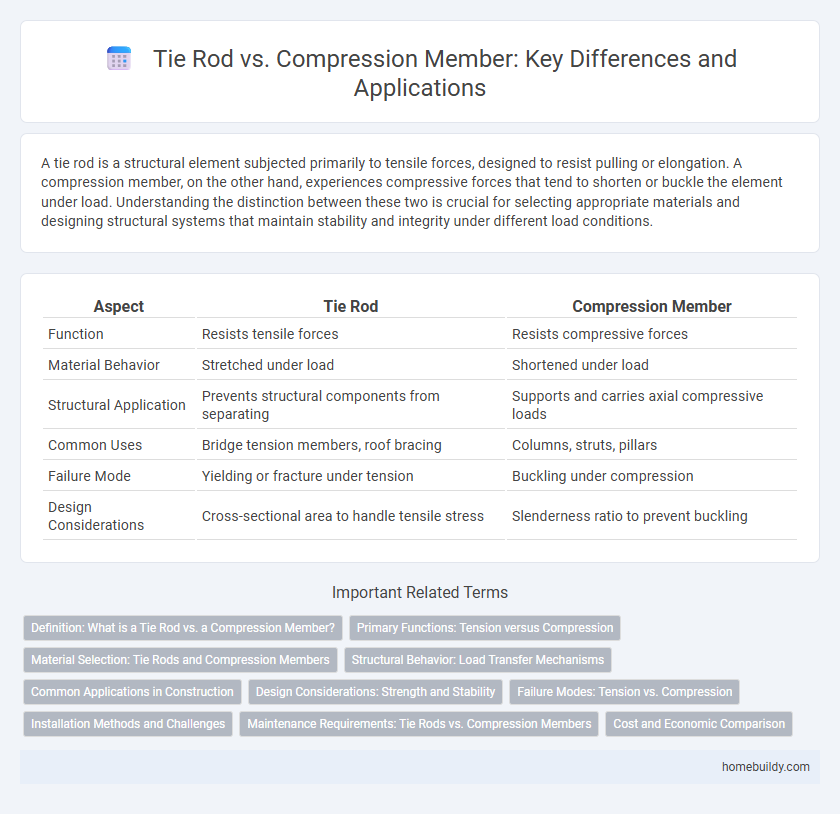A tie rod is a structural element subjected primarily to tensile forces, designed to resist pulling or elongation. A compression member, on the other hand, experiences compressive forces that tend to shorten or buckle the element under load. Understanding the distinction between these two is crucial for selecting appropriate materials and designing structural systems that maintain stability and integrity under different load conditions.
Table of Comparison
| Aspect | Tie Rod | Compression Member |
|---|---|---|
| Function | Resists tensile forces | Resists compressive forces |
| Material Behavior | Stretched under load | Shortened under load |
| Structural Application | Prevents structural components from separating | Supports and carries axial compressive loads |
| Common Uses | Bridge tension members, roof bracing | Columns, struts, pillars |
| Failure Mode | Yielding or fracture under tension | Buckling under compression |
| Design Considerations | Cross-sectional area to handle tensile stress | Slenderness ratio to prevent buckling |
Definition: What is a Tie Rod vs. a Compression Member?
A tie rod is a structural element designed to resist tensile forces, effectively pulling components together and maintaining tension within a framework. In contrast, a compression member is engineered to withstand compressive loads, preventing structural elements from buckling or collapsing under pressure. Understanding the distinct roles of tie rods and compression members is crucial for optimizing the stability and integrity of engineering and architectural designs.
Primary Functions: Tension versus Compression
Tie rods primarily function by resisting tension forces, effectively holding structural elements together and preventing them from being pulled apart. In contrast, compression members are designed to withstand compressive forces, supporting loads by bearing weight and preventing buckling. Understanding the distinction between tie rods and compression members is essential for optimizing structural integrity and load distribution in engineering designs.
Material Selection: Tie Rods and Compression Members
Tie rods typically require high-tensile steel to withstand tensile forces, ensuring durability and flexibility under load. Compression members often use materials with high compressive strength such as structural steel or reinforced concrete to resist buckling and crushing. Selecting appropriate materials based on mechanical properties and load conditions enhances the structural integrity and longevity of both tie rods and compression members.
Structural Behavior: Load Transfer Mechanisms
Tie rods function primarily in tension, transferring tensile loads by elongating under applied forces, unlike compression members that bear loads through axial compression and risk buckling. The load transfer mechanism in tie rods involves direct tensile force transmission along the rod's length, ensuring stability in structures by resisting pulling forces. Compression members, conversely, transfer loads through axial compression, demanding careful design to prevent instability caused by buckling under load.
Common Applications in Construction
Tie rods are primarily used in construction to resist tensile forces, often found in roof trusses, bridges, and structural frameworks where tension stabilization is critical. Compression members, such as columns and struts, are designed to support axial compression loads in building frames, towers, and bridge piers. Both components play complementary roles in structural engineering, ensuring overall stability by managing different types of stress in common applications like steel frameworks and reinforced concrete structures.
Design Considerations: Strength and Stability
Tie rods primarily resist tensile forces and require high tensile strength materials to maintain stability under load, whereas compression members must be designed to prevent buckling by considering slenderness ratio and critical load. Design considerations for tie rods emphasize the tensile capacity, material ductility, and effective anchorage, while compression members demand stability analysis, cross-sectional geometry optimization, and bracing systems to enhance load-bearing capacity. Ensuring appropriate factor of safety against yielding and instability is crucial for both tie rods and compression members to achieve structural integrity.
Failure Modes: Tension vs. Compression
Tie rods primarily fail due to tension-induced yielding or fracture, as they are designed to carry tensile loads, whereas compression members commonly fail by buckling or crushing under compressive stress. The slender geometry of tie rods allows efficient tensile load transfer but lacks resistance against compressive instability, differentiating their failure modes from compression members. Understanding these distinct failure behaviors is critical for optimizing structural design and material selection in load-bearing applications.
Installation Methods and Challenges
Tie rods require tensioning during installation, often involving turnbuckles or hydraulic jacks to achieve precise axial force, while compression members demand careful alignment and bracing to prevent buckling under load. Installation challenges for tie rods center on maintaining proper tension and avoiding elongation, whereas compression members face difficulties related to slenderness and lateral stability. The choice of fastening techniques and support systems directly impacts the structural performance and durability of both components in construction.
Maintenance Requirements: Tie Rods vs. Compression Members
Tie rods require regular inspection for tension adjustments and corrosion to maintain structural integrity, while compression members primarily need checks for buckling and material fatigue. Maintenance of tie rods often involves monitoring tensile forces and replacing worn-out end fittings, whereas compression members demand careful evaluation of load-bearing capacity and deformation. Proper maintenance ensures longevity and safety in both tie rods and compression members within structural frameworks.
Cost and Economic Comparison
Tie rods generally offer a more cost-effective solution compared to compression members due to their simpler design and reduced material requirements. Their slender profile minimizes the use of heavy steel, lowering fabrication and transportation expenses significantly. Economically, tie rods also reduce long-term maintenance costs by eliminating buckling concerns inherent in compression members, making them preferable for structures prioritizing budget efficiency.
tie rod vs compression member Infographic

 homebuildy.com
homebuildy.com